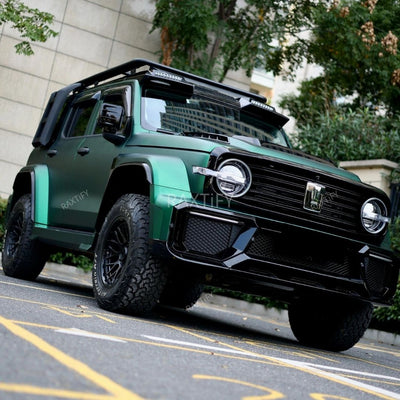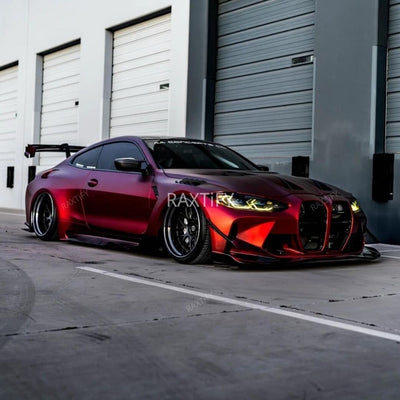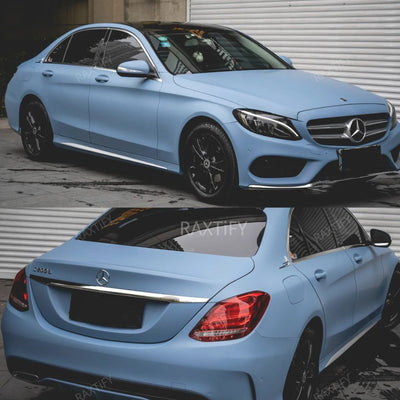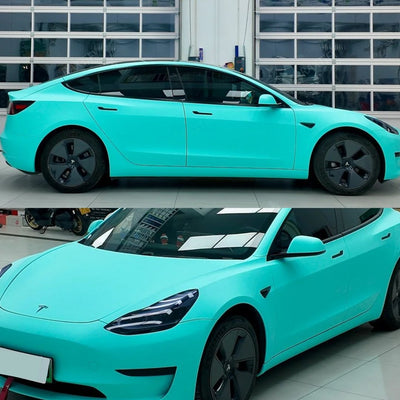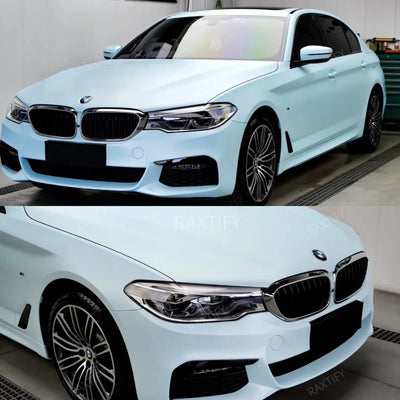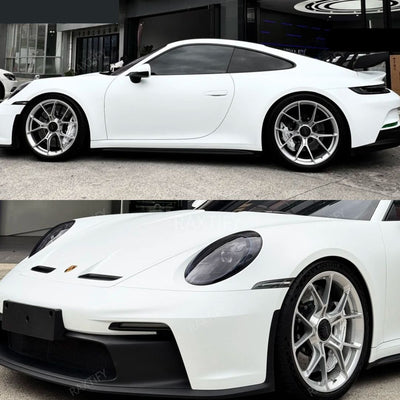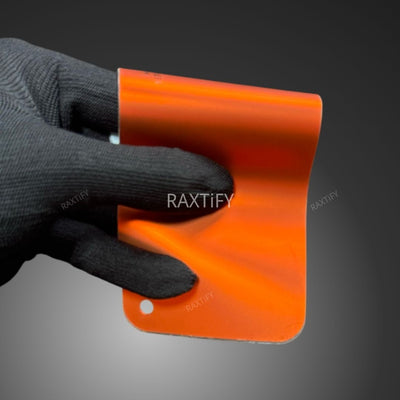Introduction
A vinyl wrap is an excellent method of revitalizing the appearance of your car, giving it bold color, character and protecting your vehicle even. However, what would you do when your car is not in top-notch condition? Does my car have some dents, dings or other signs of imperfections on the surface and you ask yourself, Can I still wrap my car? Will the vinyl conceal the damage, or increase it?
Simply put, at RAXTiFY, drivers constantly ask us this question, as they want to redesign their cars with a midway option between a full respray and expensive bodywork. The silver lining is? Can you wrap a car that has dents? Yes, and a couple of key points should be taken into consideration before you dive into it.
We have written this guide to provide you with a breakdown of all you should know about doing this to a car with dents- including the behaviors of vinyl on the damaged panel, when it is or is not economical to fix the panel before wrapping, what sort of wraps do well in this application, and more. Is it full-body wrap or are you simply trying to cover up a faded fender, whichever your option is, this article will assist you in making the right choice.
Can Vinyl Wrap be used on a dented surface?
A vinyl wrapping can certainly be applied to a dented surface but that does not necessarily mean it will look good. There are formulas that make vinyl stretch to the precise contour on the surface it was used on. This implies that it will track every dent, ding, ripple, and impairment and in most cases they emphasize the defects more than concealing them.
Unlike paint, vinyl is a material that does not fill and gaps and smooth surfaces. When the wrap is placed on top of dent it absorbs into that portion that is damaged and this further causes the dent to be highlighted especially when it is painted with gloss or metallic paint which reflects light.
Functionally, high-quality vinyl-the kind used in RAXTiFY, such as the premium calendared films-can still have adhesive on the surface that will hold a dented panel that is cleaned and prepared correctly. Nevertheless, because of the irregularity of the surface, you are more likely to come across:
- Bubbles of air stuck in between
- Variability in adhesion
- Wrinkles or stretch marks
- Raised edges around the dented part with the passage of time
Individuals that seek perfect result or show-car finish, then direct application of the vinyl over a dent is not advised. However, you should always keep in mind that no matter how insignificant the flaws on your car are, wrapping may still cross the line, just be aware of what you can do to it.
Is It Necessary to Fix the Dent Before Wrap?
At least, it is strongly advised to repair the mechanical damages like visible dents and creases in your car prior to the wrapping process, at least, in case you are striving to achieve an aesthetic and portrayal professional look. Although it is possible to apply vinyl wrap to pretty much all surfaces, it is not going to make a non-smooth surface smooth all of a sudden. Actually the wrap film will be fit around the panel shape and hence the dents, the dings, and the warps will still be eminent after the wrap is on, and sometimes even more evident on glossy or reflective films.
Practically, the act of wrapping over dent mistakes, without repair may cause problems such as:
- The creation of air bubbles in depressed places
- The inability to adhere well in edges or rough surfaces
- Premature delamination or blistering with ageing.
a smooth surface is also conducive in a well-prepped surface to a better durability and flawless finish. Dent repair prior to the wrap is not only cosmetically desirable, but it will also help preserve the investment of the wrap due to early failure.
Nonetheless, when you are wrapping the temporary use car or cars with commercial purposes, or wrapping when you are on a tight budget limit, and you do not mind that the dents will be noticeable, you can indeed still wrap the car with the dents being there. You just need to be conscious of the compromises of looks and durability.
In short: Repair the dent to get a high quality finish. I just skip it when I do not mind imperfections getting through.
Can Vinyl Wrap Hide Other Imperfections?
Although vinyl wrap is not a magic bullet, it can amazingly well at downplaying the look of such surface defects in many cases, particularly when applied intelligently with the appropriate materials.
What Vinyl Wrap Can Conceal:
1. Scratch-Light
In the event that you have a light clear-coat scratch or the swirl marks on your car, then a vinyl wrap will be able to cover it effectively. Upon application, the wrap becomes used as a second layer of skin that covers these small scratches and achieving an even, new appeal on the vehicle.
2. Worn or dreadful paint
A wrap can be highly beneficial when it comes to older cars with paint that has been faded by the sun or has an uneven coat of paint. The car can also be made to look new again by applying gloss, satin or metallic finishes that do not require any paint work to be done.
3. Small spots or marks
Any stains or discoloration that have not embedded very deep into the paint are not normally seen when it is wrapped especially when using darker films or regular texture films.
What a Wrap Can’t Hide:
1. Scratch marks or damage that cuts deep into the wood
These flaws may also provide sort of a texture that can be viewed beneath the vinyl particularly when you are using the high-gloss wraps. The wrap will adhere with surface shape, thus deep injuries may even be visible.
2. Pitting of rust, or peeling paint
Vinyl wrap does not stick too well on rusted or peeled surfaces. Actually, covering rust is not always good as it results in the lack of good adhesion and a subsequent aggravation of the issue.
3. Acute dents and irregular surface
A dent or any body work problem will still remain visible under the film- the wrap will still make itself around the problem not flattening or covering it up.
Tips for Wrapping a Car with Dents or Imperfections
1. Clean and Wash Proper and Degrease
Begin by having a clean surface to work from, either by utilizing a wax and grease remover or isopropyl alcohol ( IP A). Even minor amounts of dirt, wax, or oil can interfere with the level of how well the wrap can adhere (particularly in the areas of the wrinkles).
Pro Tip: Watch out for dents and creased regions that dirt can settle in to accumulate more over time.
2. Medium Scrub Away Knife -Sharpomes
When the dent has sharp or rough edges, it is good to slightly sand the place to smoothen abrupt transitions. This helps prevent wrap tearing or creasing in the wrap during installation.
Important: Do not sand too much or create any deep holes in the wood since the idea here is to smoothen the wood out and not to dig any deep holes.
3. To get a Flatter Surface (If You Need It) Use Body Filler
In the case of dent visible that you desire to have a smooth and high-gloss finish (especially wraps such as Gloss Metallic Royal Purple or Gloss White), you want to apply a body filler to flatten out the dent instead.
Why? Vinyl will adhere to the surface- there will be a dent, a crevice, a dent or a crack, and it will still be seen on the surface.
4. Top Save-Question Mark
When desired the dented places or previously painted areas can be filled and sanded before being given a thin coating of primer/adhesion promoter and then wrapped. This helps to make the vinyl adhere better and to stay from flipping in nasty spots.
5. Comb out Near the Dents
When stretched, vinyl wrap is likely to lose some thickness and, as a result, diminish its own opacity, as well as precondition wrap failure in some spots that are either curved or damaged. Apply a heat gun carefully and do not overstretch it.
Best Practice: During the process of getting the vinyl into dents, do not push it violently into the dents.
6. The Right Finish must be selected to Minimize Imperfections
- Light flaws are disguised by the use of matte and satin finishes.
- Sparkly drapes will show scratches in a more pronounced manner.
- Metallic or chrome wraps bring out flaws in the surface of a panel - do not use on dented panels.
7. Pass Final Heat (Post-Heat)
When the vinyl is positioned then final heat pass can be applied around edges, dents and recessed parts. It involves this so-called post-heating that fixes the adhesive and avoids lifting later.
Conclusion
Covering dented cars is not out of the question, though you may want to consider that doing so is the wrong move. A vinyl wrap can still provide protection and unique style to your car at a discounted rate because it is fast and easier, and a few flaws in the work are acceptable. Unless you want a perfect, showroom finish, though, it is a good idea to get rid of any dents or other flaws in the surface prior to wrapping.
A great tip with RAXTiFY is to make sure you begin with a smooth foundation, in order to achieve the best results with your wrap. However, regardless of the state of your vehicle, we can provide a large variety of high functionality and flexible vinyl wraps that fit perfectly- even to a rather flawed surface.
Need to do something with your car, dents and all? Check out our version of mysterious color choices and attain that eye catching finish now.







